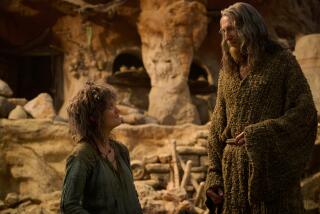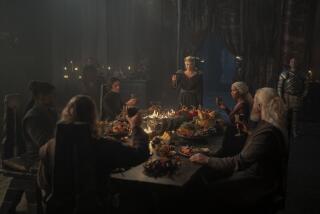A sometimes-shifting line between fantasy, reality
- Share via
Most people don’t need a map to know that Middle-earth isn’t anywhere near Iraq. Or North Korea for that matter. But “Lord of the Rings” star Viggo Mortensen felt the need to remind people of that salient geographical fact a few weeks back when he appeared on “The Charlie Rose Show” in a homemade T-shirt that read “No More Blood for Oil.” Apparently, Mortensen was mortified at hearing people projecting simplistic, post-Sept. 11 analogies onto J.R.R. Tolkien’s mythical universe of hobbits, orcs and hirsute sorcerers.
But if Mortensen objects to others reading current events into “Lord of the Rings: The Two Towers,” the movie’s producers apparently don’t share his qualms. Ads for each of the first two films in the trilogy have sported quotes alluding to the need for courage and resolve in difficult times, lines clearly meant to trigger thoughts of Sept. 11 and its aftermath.
Tolkien himself no doubt would’ve approved of Mortensen’s tough stance against interpretation. The tweedy, pipe-smoking Oxford don was rather prickly about anyone reading timely events into his trilogy, which he wrote between 1936 and 1949 -- years that witnessed a world war, the birth of the A-bomb and the death rattle of the British Empire. “It is neither allegorical nor topical,” he declared in his preface to the trilogy’s second edition. “I cordially dislike allegory in all its manifestations.”
Should we take Tolkien at his word? Is his trilogy really a pop culture phenomenon and the progenitor of an entire fantasy subgenre simply because it’s a whopping great yarn about little men with big, hairy feet? Or are we entitled to dig beneath the author’s stated intent, hoping to gain some insight into why “The Two Towers” film has already raked in nearly $300 million?
Unlike certain less grandiose forms of fiction, sprawling epics such as Tolkien’s ring cycle lend themselves to all manner of interpretations. Whatever your worldview, you may be able to find some reflection of it in “Lord of the Rings.”
Although Tolkien was a Roman Catholic, it might be more accurate to call him a Romantic. “The Lord of the Rings” belongs in the rear guard of European Romanticism, that brooding, swooning period of nature-loving poets and intoxicating sonatas that first swept across the continent in the late 1700s. Romanticism was a reaction to the turmoil of the French Revolution, the unrelieved rationalism of the Enlightenment and the sooty onset of the Industrial Revolution.
Fundamentally fearful and suspicious of the coming modern age, the Romantics took solace in desolate Roman ruins, tempestuous love affairs, the heroic myths of the past and wandering lonely as a cloud o’er hill and dale. It was a movement tailor-made for nostalgics, all right, but also for skeptics who knew that progress isn’t always progressive.
Like most Romantics, Tolkien looked backward more than forward for inspiration. A linguist and scholar of medieval literature who devoted his career to the great Anglo-Saxon tooth-and-claw epic poem “Beowulf,” he shunned the literary fashions of 1930s Britain. While the Bloomsbury group was writing about sex and psychological angst, Tolkien was staging archaic literary battles between Good and Evil, set on a Wagnerian scale.
“The books are heroic and they’re virtuous. And that’s not exactly allegory; they might be symbolic. I don’t read him as ideological as [opera composer Richard] Wagner. But I think heroic, certainly,” says Charles Muscatine, a UC Berkeley professor emeritus of medieval literature.
Tolkien’s political leanings, like his spiritual ones, can’t be neatly pigeonholed. In his letters he expressed a kind of radical dubiousness about modern warfare’s aims, technology’s benefits, and especially toward those wielding power, whatever their objectives. He mourned the accelerating subdivision and paving over of the English countryside, a catastrophe echoed in the destruction of the Shire, the hobbits’ pastoral haven.
Over the past half-century, some critics have wanted to read “The Two Towers” as an allegory of British resistance to Nazi Germany, with the embattled citadel of Helm’s Deep standing in for Fortress Britannica, circa 1940. Today, some commentators are trying to contort the story of the Two Towers into the tragedy of the twin towers.
But what Tolkien is really expressing in “Lord of the Rings,” says Jed Wyrick, a professor of religion at Cal State Chico, isn’t jingoistic propaganda, but a profound sense of foreboding about the loss of a world pregnant with meaning, a world in which a forest, a glade or even the words of a language can possess ancient, multiple inner lives. A world, Tolkien feared, in which everything worth treasuring might soon be overrun by the lock-step march of modernity.
“There’s a remarkable similarity between Tolkien’s idea of what technology is and what Martin Heidegger said about the turning of the world around us [into] something waiting to be exploited, that technology sees the world as something ripe for our picking,” Wyrick says, referring to the German existentialist philosopher. In Tolkien’s trilogy, the ultimate symbols of technology are the rings, which treat people themselves as mere cannon fodder. The hobbits are virtuous “because they’re so simple, because they don’t desire wanting to use other things as resources to be plundered. They can resist.”
The fuller picture
Those who wish to turn Tolkien into a champion of modern Western values might also want to consider his less-than-flattering views of non-Western cultures. Though Tolkien loathed and denounced the Third Reich, he also expressed an aesthetic love of “the noble, Northern spirit,” a sentiment that wouldn’t have been out of place at a Nuremberg rally. Among the villains of “The Two Towers” are the “swarthy,” subhuman orcs and the Haradrim, the dark-skinned, turban-wearing men of the south whose appearance (especially as rendered in the film version) is in marked contrast to the light-skinned, Anglo-Celtic-style heroes. In an article posted on the Web, British scholar Stephen Shapiro notes that in some European countries, “Tolkien has become the darling for the extreme far right,” whose denizens have seized on his blood-and-iron myths to buttress their fascist beliefs.
This isn’t to condemn Tolkien with 21st-century hindsight. It’s merely to suggest that, however much he resisted the notion, he was, like most of us, a creature of his times. He couldn’t help absorbing the free-floating anxieties and biases of his age any more than we can help breathing the intellectual ether of ours.
And that’s the point: Symbols and allegories are usually in the eye of a particular beholder, standing in a particular place and time. Like the ring of Tolkien’s fable, they are powerful tools that may be easily bent toward agendas their makers never intended. So as the interpretative layers pile on, like tarnished metal, don’t forget to consider the source.
*
Reed Johnson can be reached at reed.johnson@latimes.com.
More to Read
Only good movies
Get the Indie Focus newsletter, Mark Olsen's weekly guide to the world of cinema.
You may occasionally receive promotional content from the Los Angeles Times.











